Marketing Fundamentals: Segmentation, Targeting, Positioning Analysis
VerifiedAdded on 2023/01/11
|9
|2056
|90
Report
AI Summary
This report provides a comprehensive overview of foundational marketing concepts. It begins by comparing selling and marketing orientations, highlighting the shift from product-centric to customer-centric approaches. The report then explains the micro and macro external environments, detailing the factors that influence business operations and decision-making. It also outlines the five stages of the buying decision process, providing insights into how consumers make purchasing choices. Furthermore, the report examines the relationship between segmentation, targeting, and positioning (STP) using the example of Tesco, illustrating how these strategies are applied in a real-world business context. Finally, the report addresses the characteristics of service industries, emphasizing their intangible nature and other key attributes. The report concludes by summarizing the importance of marketing foundations for business success.

Foundations of
Marketing
Marketing
Paraphrase This Document
Need a fresh take? Get an instant paraphrase of this document with our AI Paraphraser
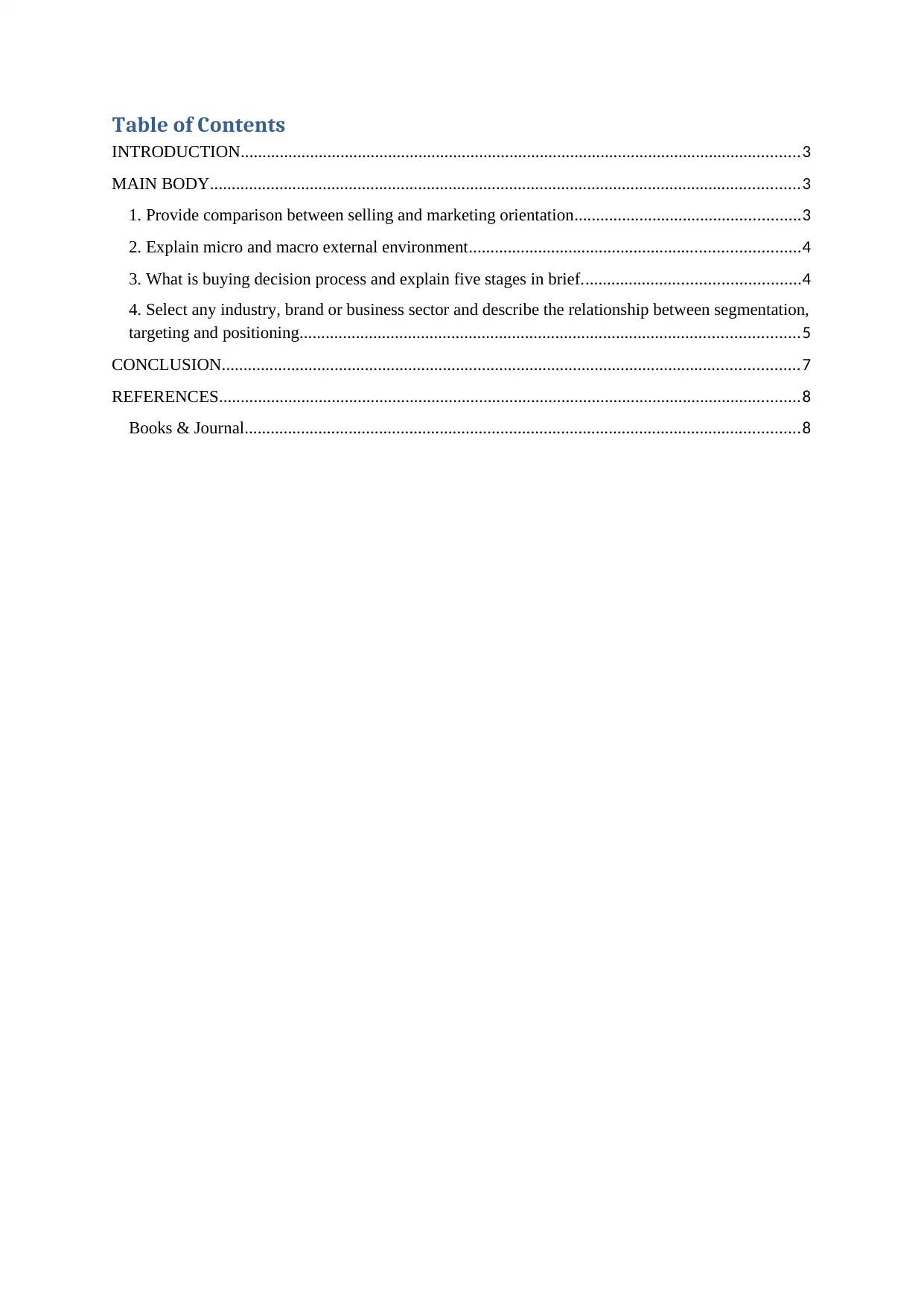
Table of Contents
INTRODUCTION.................................................................................................................................3
MAIN BODY........................................................................................................................................3
1. Provide comparison between selling and marketing orientation....................................................3
2. Explain micro and macro external environment............................................................................4
3. What is buying decision process and explain five stages in brief..................................................4
4. Select any industry, brand or business sector and describe the relationship between segmentation,
targeting and positioning...................................................................................................................5
CONCLUSION.....................................................................................................................................7
REFERENCES......................................................................................................................................8
Books & Journal................................................................................................................................8
INTRODUCTION.................................................................................................................................3
MAIN BODY........................................................................................................................................3
1. Provide comparison between selling and marketing orientation....................................................3
2. Explain micro and macro external environment............................................................................4
3. What is buying decision process and explain five stages in brief..................................................4
4. Select any industry, brand or business sector and describe the relationship between segmentation,
targeting and positioning...................................................................................................................5
CONCLUSION.....................................................................................................................................7
REFERENCES......................................................................................................................................8
Books & Journal................................................................................................................................8
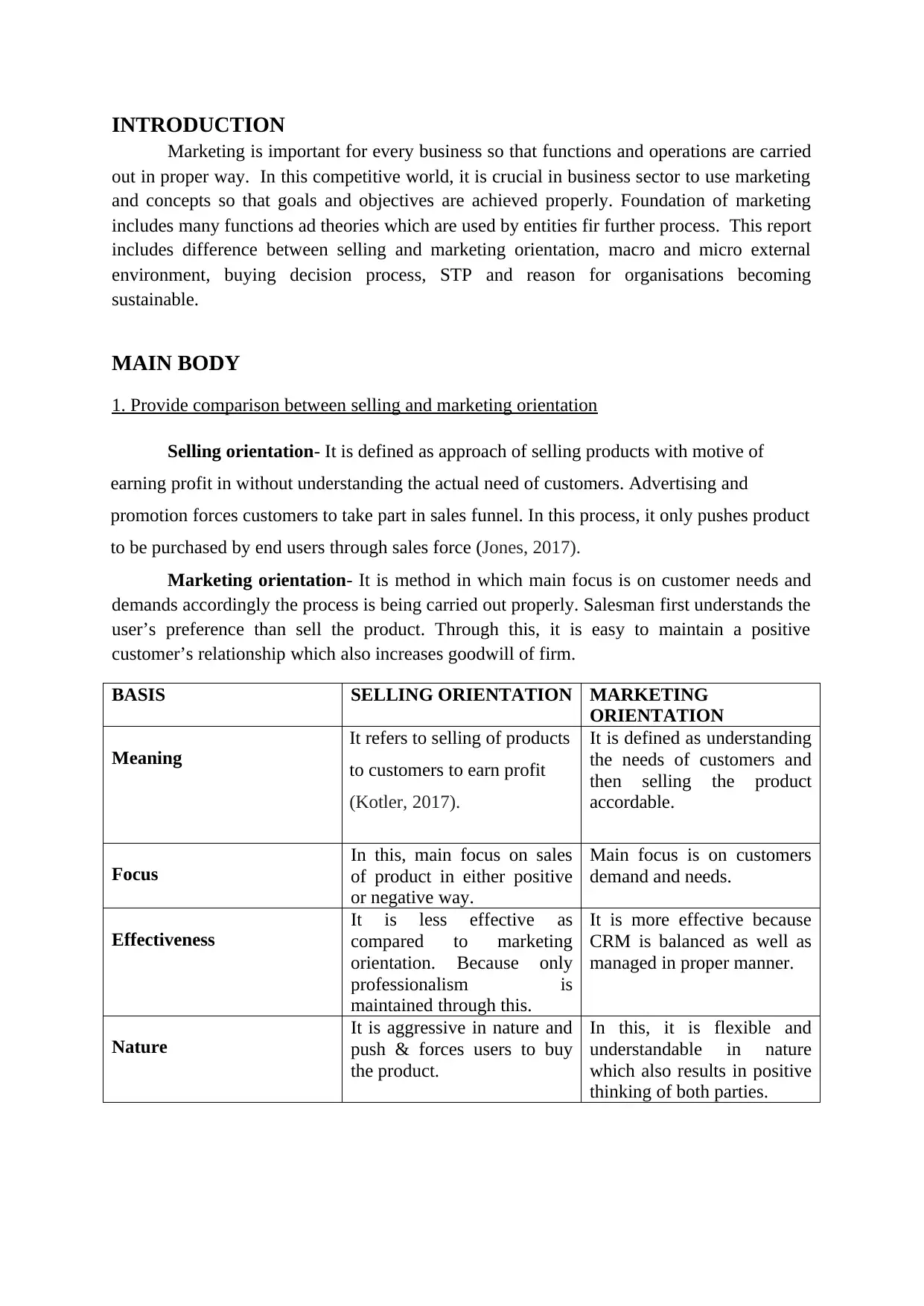
INTRODUCTION
Marketing is important for every business so that functions and operations are carried
out in proper way. In this competitive world, it is crucial in business sector to use marketing
and concepts so that goals and objectives are achieved properly. Foundation of marketing
includes many functions ad theories which are used by entities fir further process. This report
includes difference between selling and marketing orientation, macro and micro external
environment, buying decision process, STP and reason for organisations becoming
sustainable.
MAIN BODY
1. Provide comparison between selling and marketing orientation
Selling orientation- It is defined as approach of selling products with motive of
earning profit in without understanding the actual need of customers. Advertising and
promotion forces customers to take part in sales funnel. In this process, it only pushes product
to be purchased by end users through sales force (Jones, 2017).
Marketing orientation- It is method in which main focus is on customer needs and
demands accordingly the process is being carried out properly. Salesman first understands the
user’s preference than sell the product. Through this, it is easy to maintain a positive
customer’s relationship which also increases goodwill of firm.
BASIS SELLING ORIENTATION MARKETING
ORIENTATION
Meaning
It refers to selling of products
to customers to earn profit
(Kotler, 2017).
It is defined as understanding
the needs of customers and
then selling the product
accordable.
Focus
In this, main focus on sales
of product in either positive
or negative way.
Main focus is on customers
demand and needs.
Effectiveness
It is less effective as
compared to marketing
orientation. Because only
professionalism is
maintained through this.
It is more effective because
CRM is balanced as well as
managed in proper manner.
Nature
It is aggressive in nature and
push & forces users to buy
the product.
In this, it is flexible and
understandable in nature
which also results in positive
thinking of both parties.
Marketing is important for every business so that functions and operations are carried
out in proper way. In this competitive world, it is crucial in business sector to use marketing
and concepts so that goals and objectives are achieved properly. Foundation of marketing
includes many functions ad theories which are used by entities fir further process. This report
includes difference between selling and marketing orientation, macro and micro external
environment, buying decision process, STP and reason for organisations becoming
sustainable.
MAIN BODY
1. Provide comparison between selling and marketing orientation
Selling orientation- It is defined as approach of selling products with motive of
earning profit in without understanding the actual need of customers. Advertising and
promotion forces customers to take part in sales funnel. In this process, it only pushes product
to be purchased by end users through sales force (Jones, 2017).
Marketing orientation- It is method in which main focus is on customer needs and
demands accordingly the process is being carried out properly. Salesman first understands the
user’s preference than sell the product. Through this, it is easy to maintain a positive
customer’s relationship which also increases goodwill of firm.
BASIS SELLING ORIENTATION MARKETING
ORIENTATION
Meaning
It refers to selling of products
to customers to earn profit
(Kotler, 2017).
It is defined as understanding
the needs of customers and
then selling the product
accordable.
Focus
In this, main focus on sales
of product in either positive
or negative way.
Main focus is on customers
demand and needs.
Effectiveness
It is less effective as
compared to marketing
orientation. Because only
professionalism is
maintained through this.
It is more effective because
CRM is balanced as well as
managed in proper manner.
Nature
It is aggressive in nature and
push & forces users to buy
the product.
In this, it is flexible and
understandable in nature
which also results in positive
thinking of both parties.
⊘ This is a preview!⊘
Do you want full access?
Subscribe today to unlock all pages.

Trusted by 1+ million students worldwide
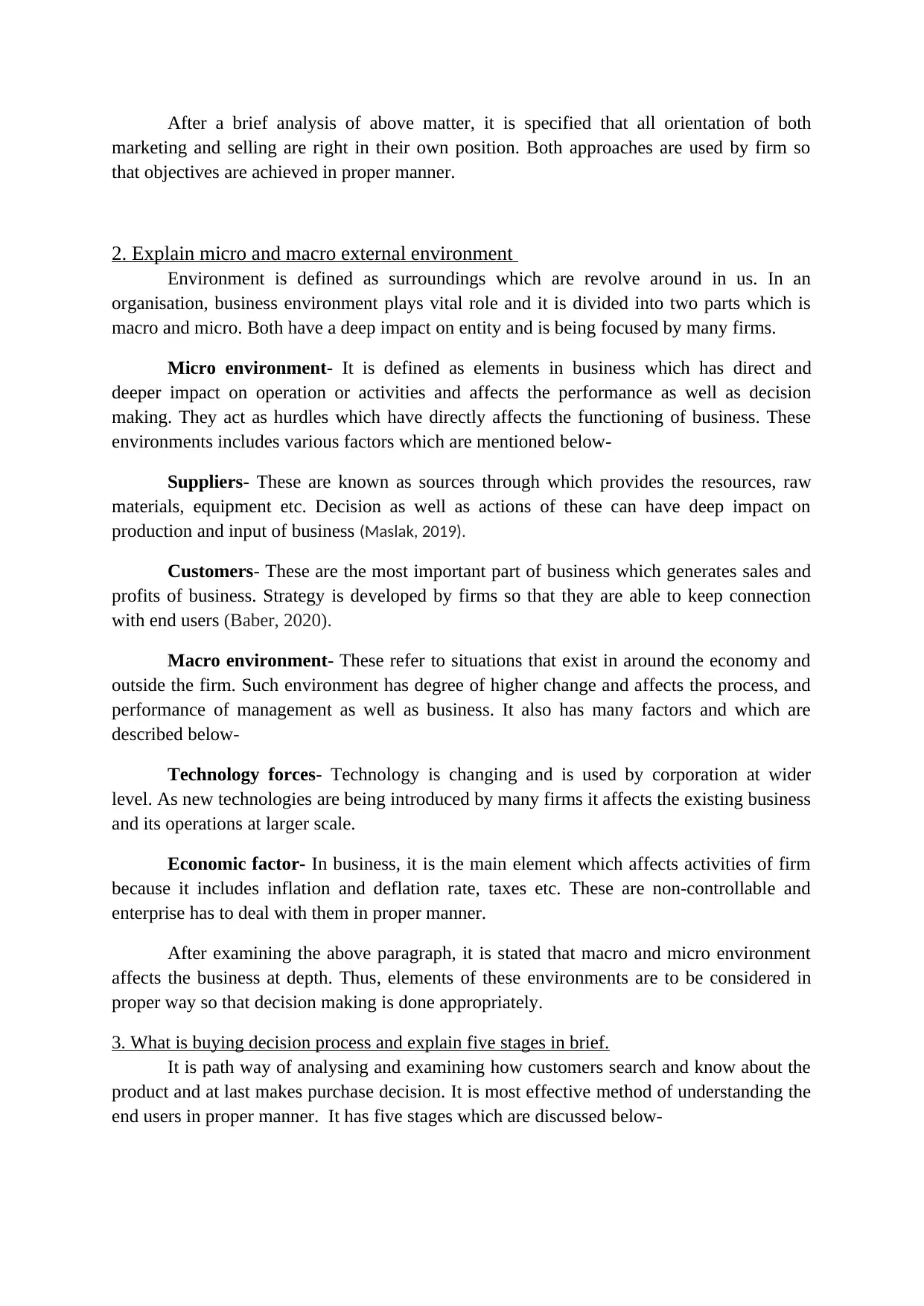
After a brief analysis of above matter, it is specified that all orientation of both
marketing and selling are right in their own position. Both approaches are used by firm so
that objectives are achieved in proper manner.
2. Explain micro and macro external environment
Environment is defined as surroundings which are revolve around in us. In an
organisation, business environment plays vital role and it is divided into two parts which is
macro and micro. Both have a deep impact on entity and is being focused by many firms.
Micro environment- It is defined as elements in business which has direct and
deeper impact on operation or activities and affects the performance as well as decision
making. They act as hurdles which have directly affects the functioning of business. These
environments includes various factors which are mentioned below-
Suppliers- These are known as sources through which provides the resources, raw
materials, equipment etc. Decision as well as actions of these can have deep impact on
production and input of business (Maslak, 2019).
Customers- These are the most important part of business which generates sales and
profits of business. Strategy is developed by firms so that they are able to keep connection
with end users (Baber, 2020).
Macro environment- These refer to situations that exist in around the economy and
outside the firm. Such environment has degree of higher change and affects the process, and
performance of management as well as business. It also has many factors and which are
described below-
Technology forces- Technology is changing and is used by corporation at wider
level. As new technologies are being introduced by many firms it affects the existing business
and its operations at larger scale.
Economic factor- In business, it is the main element which affects activities of firm
because it includes inflation and deflation rate, taxes etc. These are non-controllable and
enterprise has to deal with them in proper manner.
After examining the above paragraph, it is stated that macro and micro environment
affects the business at depth. Thus, elements of these environments are to be considered in
proper way so that decision making is done appropriately.
3. What is buying decision process and explain five stages in brief.
It is path way of analysing and examining how customers search and know about the
product and at last makes purchase decision. It is most effective method of understanding the
end users in proper manner. It has five stages which are discussed below-
marketing and selling are right in their own position. Both approaches are used by firm so
that objectives are achieved in proper manner.
2. Explain micro and macro external environment
Environment is defined as surroundings which are revolve around in us. In an
organisation, business environment plays vital role and it is divided into two parts which is
macro and micro. Both have a deep impact on entity and is being focused by many firms.
Micro environment- It is defined as elements in business which has direct and
deeper impact on operation or activities and affects the performance as well as decision
making. They act as hurdles which have directly affects the functioning of business. These
environments includes various factors which are mentioned below-
Suppliers- These are known as sources through which provides the resources, raw
materials, equipment etc. Decision as well as actions of these can have deep impact on
production and input of business (Maslak, 2019).
Customers- These are the most important part of business which generates sales and
profits of business. Strategy is developed by firms so that they are able to keep connection
with end users (Baber, 2020).
Macro environment- These refer to situations that exist in around the economy and
outside the firm. Such environment has degree of higher change and affects the process, and
performance of management as well as business. It also has many factors and which are
described below-
Technology forces- Technology is changing and is used by corporation at wider
level. As new technologies are being introduced by many firms it affects the existing business
and its operations at larger scale.
Economic factor- In business, it is the main element which affects activities of firm
because it includes inflation and deflation rate, taxes etc. These are non-controllable and
enterprise has to deal with them in proper manner.
After examining the above paragraph, it is stated that macro and micro environment
affects the business at depth. Thus, elements of these environments are to be considered in
proper way so that decision making is done appropriately.
3. What is buying decision process and explain five stages in brief.
It is path way of analysing and examining how customers search and know about the
product and at last makes purchase decision. It is most effective method of understanding the
end users in proper manner. It has five stages which are discussed below-
Paraphrase This Document
Need a fresh take? Get an instant paraphrase of this document with our AI Paraphraser
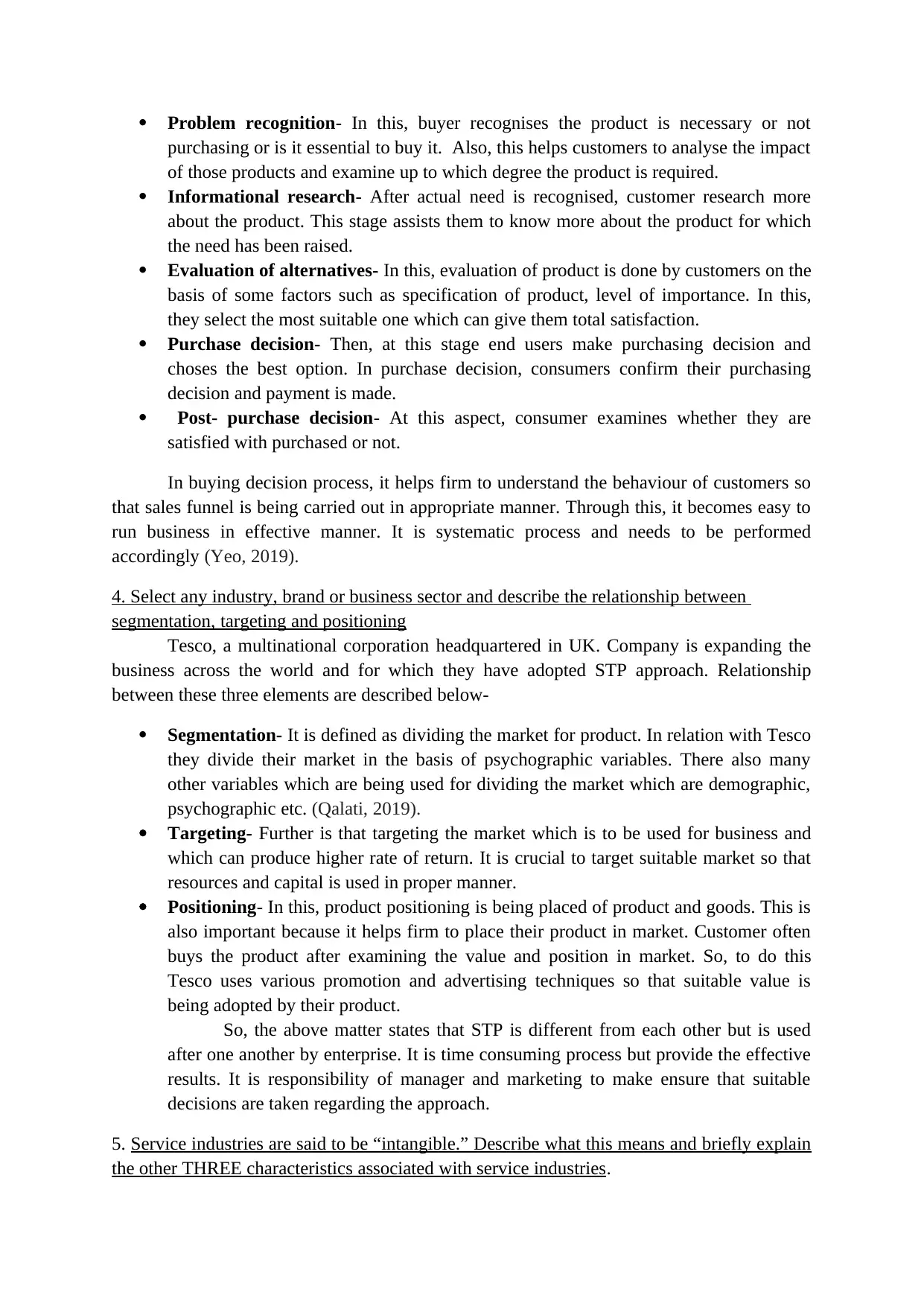
Problem recognition- In this, buyer recognises the product is necessary or not
purchasing or is it essential to buy it. Also, this helps customers to analyse the impact
of those products and examine up to which degree the product is required.
Informational research- After actual need is recognised, customer research more
about the product. This stage assists them to know more about the product for which
the need has been raised.
Evaluation of alternatives- In this, evaluation of product is done by customers on the
basis of some factors such as specification of product, level of importance. In this,
they select the most suitable one which can give them total satisfaction.
Purchase decision- Then, at this stage end users make purchasing decision and
choses the best option. In purchase decision, consumers confirm their purchasing
decision and payment is made.
Post- purchase decision- At this aspect, consumer examines whether they are
satisfied with purchased or not.
In buying decision process, it helps firm to understand the behaviour of customers so
that sales funnel is being carried out in appropriate manner. Through this, it becomes easy to
run business in effective manner. It is systematic process and needs to be performed
accordingly (Yeo, 2019).
4. Select any industry, brand or business sector and describe the relationship between
segmentation, targeting and positioning
Tesco, a multinational corporation headquartered in UK. Company is expanding the
business across the world and for which they have adopted STP approach. Relationship
between these three elements are described below-
Segmentation- It is defined as dividing the market for product. In relation with Tesco
they divide their market in the basis of psychographic variables. There also many
other variables which are being used for dividing the market which are demographic,
psychographic etc. (Qalati, 2019).
Targeting- Further is that targeting the market which is to be used for business and
which can produce higher rate of return. It is crucial to target suitable market so that
resources and capital is used in proper manner.
Positioning- In this, product positioning is being placed of product and goods. This is
also important because it helps firm to place their product in market. Customer often
buys the product after examining the value and position in market. So, to do this
Tesco uses various promotion and advertising techniques so that suitable value is
being adopted by their product.
So, the above matter states that STP is different from each other but is used
after one another by enterprise. It is time consuming process but provide the effective
results. It is responsibility of manager and marketing to make ensure that suitable
decisions are taken regarding the approach.
5. Service industries are said to be “intangible.” Describe what this means and briefly explain
the other THREE characteristics associated with service industries.
purchasing or is it essential to buy it. Also, this helps customers to analyse the impact
of those products and examine up to which degree the product is required.
Informational research- After actual need is recognised, customer research more
about the product. This stage assists them to know more about the product for which
the need has been raised.
Evaluation of alternatives- In this, evaluation of product is done by customers on the
basis of some factors such as specification of product, level of importance. In this,
they select the most suitable one which can give them total satisfaction.
Purchase decision- Then, at this stage end users make purchasing decision and
choses the best option. In purchase decision, consumers confirm their purchasing
decision and payment is made.
Post- purchase decision- At this aspect, consumer examines whether they are
satisfied with purchased or not.
In buying decision process, it helps firm to understand the behaviour of customers so
that sales funnel is being carried out in appropriate manner. Through this, it becomes easy to
run business in effective manner. It is systematic process and needs to be performed
accordingly (Yeo, 2019).
4. Select any industry, brand or business sector and describe the relationship between
segmentation, targeting and positioning
Tesco, a multinational corporation headquartered in UK. Company is expanding the
business across the world and for which they have adopted STP approach. Relationship
between these three elements are described below-
Segmentation- It is defined as dividing the market for product. In relation with Tesco
they divide their market in the basis of psychographic variables. There also many
other variables which are being used for dividing the market which are demographic,
psychographic etc. (Qalati, 2019).
Targeting- Further is that targeting the market which is to be used for business and
which can produce higher rate of return. It is crucial to target suitable market so that
resources and capital is used in proper manner.
Positioning- In this, product positioning is being placed of product and goods. This is
also important because it helps firm to place their product in market. Customer often
buys the product after examining the value and position in market. So, to do this
Tesco uses various promotion and advertising techniques so that suitable value is
being adopted by their product.
So, the above matter states that STP is different from each other but is used
after one another by enterprise. It is time consuming process but provide the effective
results. It is responsibility of manager and marketing to make ensure that suitable
decisions are taken regarding the approach.
5. Service industries are said to be “intangible.” Describe what this means and briefly explain
the other THREE characteristics associated with service industries.
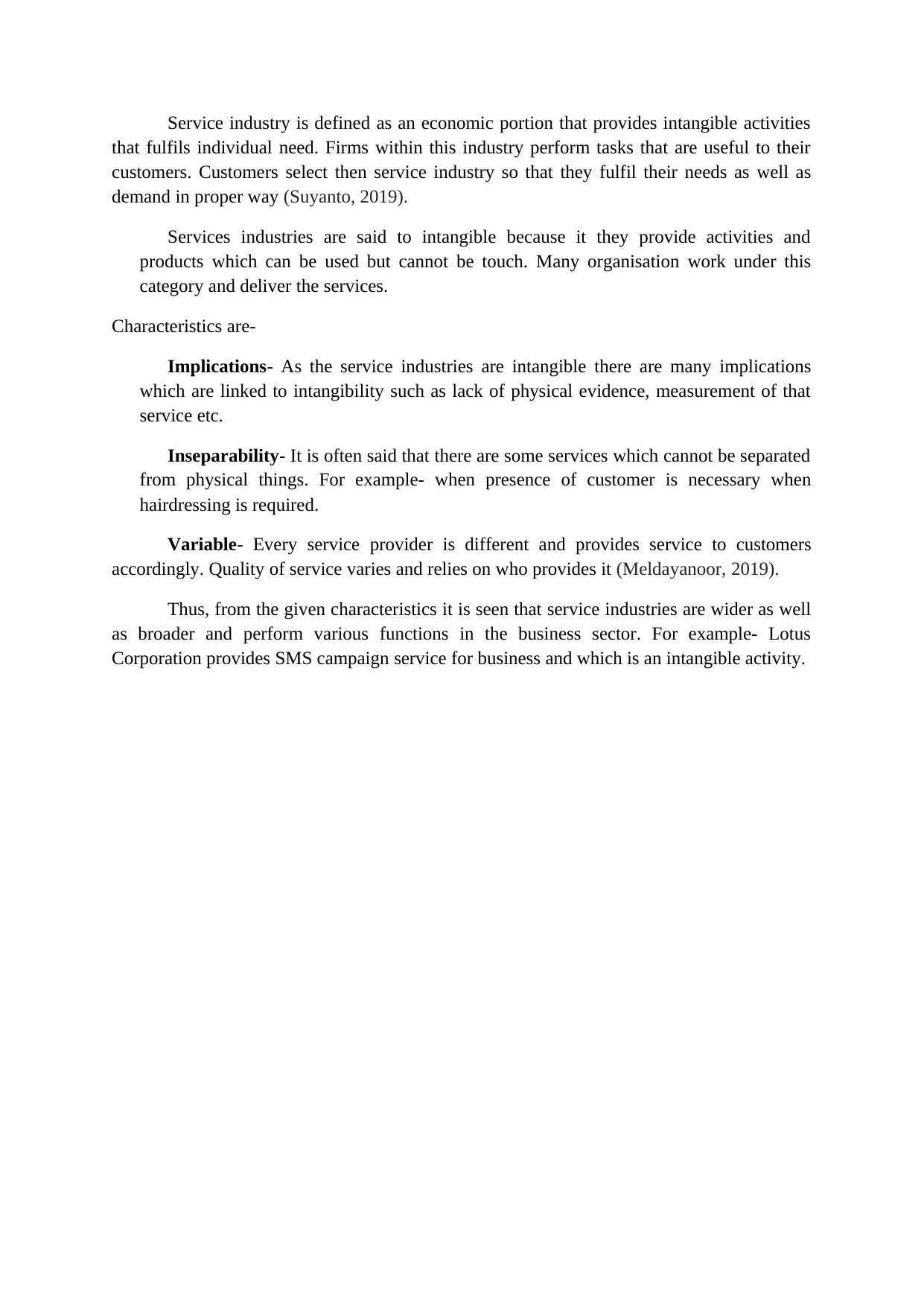
Service industry is defined as an economic portion that provides intangible activities
that fulfils individual need. Firms within this industry perform tasks that are useful to their
customers. Customers select then service industry so that they fulfil their needs as well as
demand in proper way (Suyanto, 2019).
Services industries are said to intangible because it they provide activities and
products which can be used but cannot be touch. Many organisation work under this
category and deliver the services.
Characteristics are-
Implications- As the service industries are intangible there are many implications
which are linked to intangibility such as lack of physical evidence, measurement of that
service etc.
Inseparability- It is often said that there are some services which cannot be separated
from physical things. For example- when presence of customer is necessary when
hairdressing is required.
Variable- Every service provider is different and provides service to customers
accordingly. Quality of service varies and relies on who provides it (Meldayanoor, 2019).
Thus, from the given characteristics it is seen that service industries are wider as well
as broader and perform various functions in the business sector. For example- Lotus
Corporation provides SMS campaign service for business and which is an intangible activity.
that fulfils individual need. Firms within this industry perform tasks that are useful to their
customers. Customers select then service industry so that they fulfil their needs as well as
demand in proper way (Suyanto, 2019).
Services industries are said to intangible because it they provide activities and
products which can be used but cannot be touch. Many organisation work under this
category and deliver the services.
Characteristics are-
Implications- As the service industries are intangible there are many implications
which are linked to intangibility such as lack of physical evidence, measurement of that
service etc.
Inseparability- It is often said that there are some services which cannot be separated
from physical things. For example- when presence of customer is necessary when
hairdressing is required.
Variable- Every service provider is different and provides service to customers
accordingly. Quality of service varies and relies on who provides it (Meldayanoor, 2019).
Thus, from the given characteristics it is seen that service industries are wider as well
as broader and perform various functions in the business sector. For example- Lotus
Corporation provides SMS campaign service for business and which is an intangible activity.
⊘ This is a preview!⊘
Do you want full access?
Subscribe today to unlock all pages.

Trusted by 1+ million students worldwide
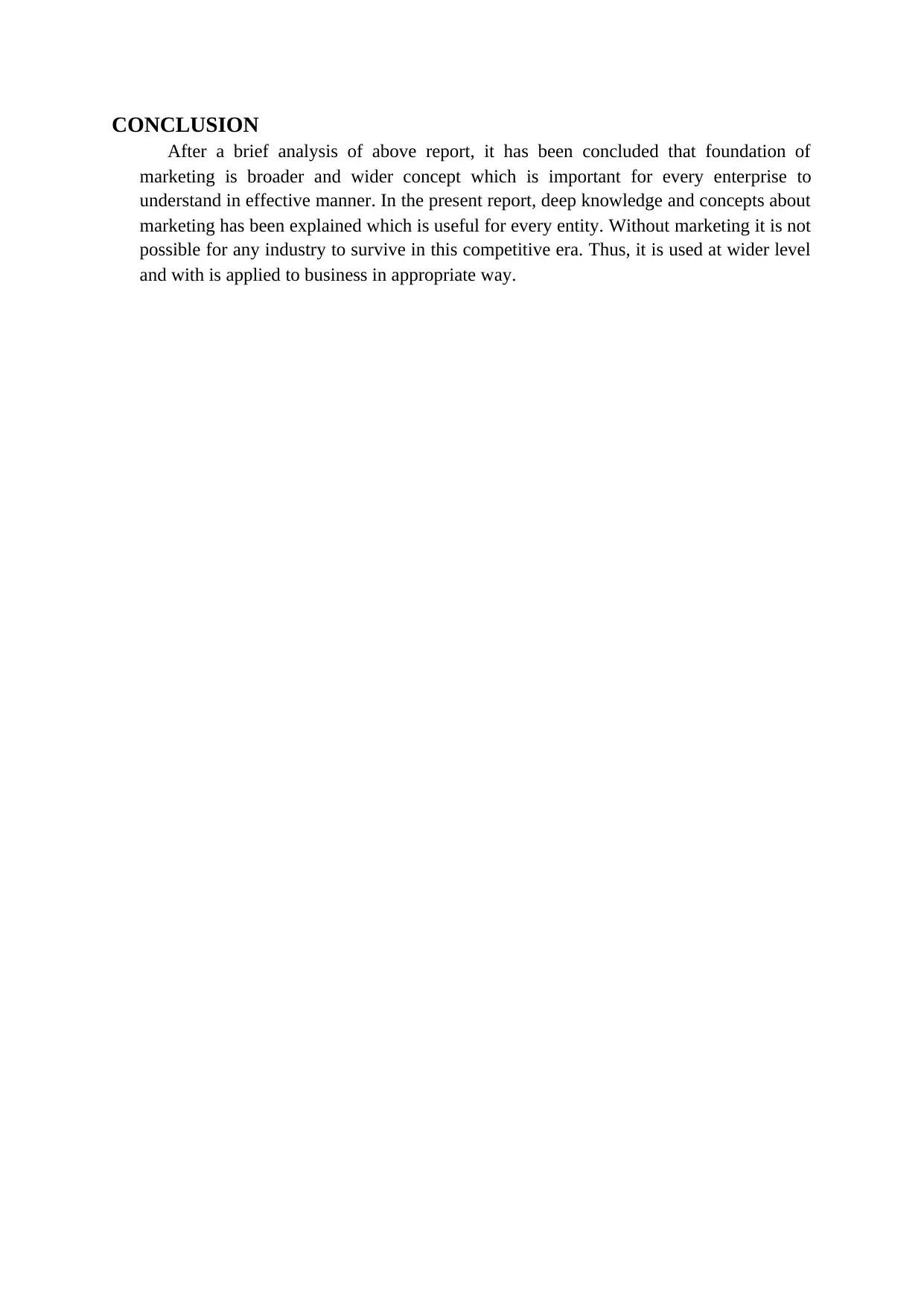
CONCLUSION
After a brief analysis of above report, it has been concluded that foundation of
marketing is broader and wider concept which is important for every enterprise to
understand in effective manner. In the present report, deep knowledge and concepts about
marketing has been explained which is useful for every entity. Without marketing it is not
possible for any industry to survive in this competitive era. Thus, it is used at wider level
and with is applied to business in appropriate way.
After a brief analysis of above report, it has been concluded that foundation of
marketing is broader and wider concept which is important for every enterprise to
understand in effective manner. In the present report, deep knowledge and concepts about
marketing has been explained which is useful for every entity. Without marketing it is not
possible for any industry to survive in this competitive era. Thus, it is used at wider level
and with is applied to business in appropriate way.
Paraphrase This Document
Need a fresh take? Get an instant paraphrase of this document with our AI Paraphraser
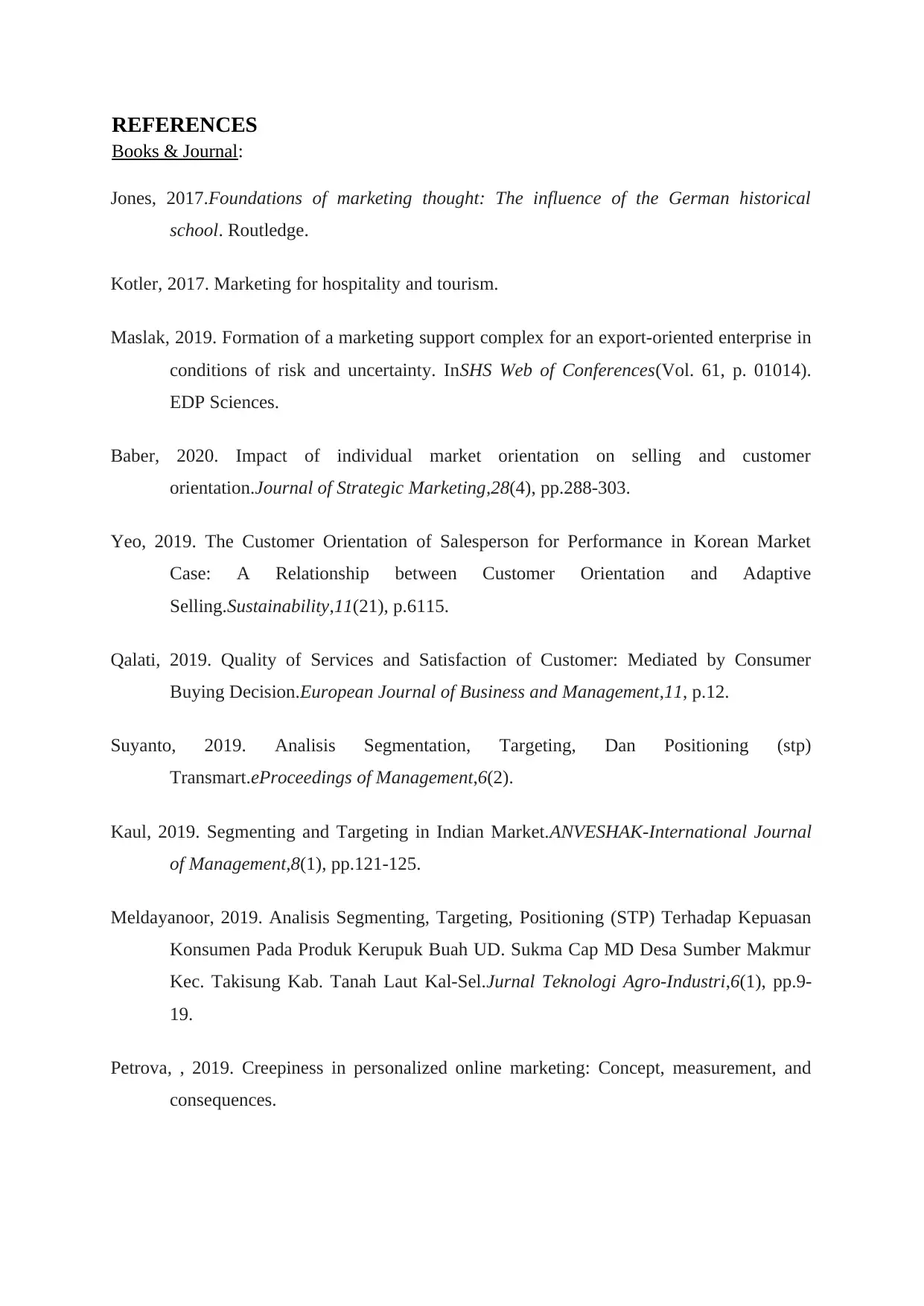
REFERENCES
Books & Journal:
Jones, 2017.Foundations of marketing thought: The influence of the German historical
school. Routledge.
Kotler, 2017. Marketing for hospitality and tourism.
Maslak, 2019. Formation of a marketing support complex for an export-oriented enterprise in
conditions of risk and uncertainty. InSHS Web of Conferences(Vol. 61, p. 01014).
EDP Sciences.
Baber, 2020. Impact of individual market orientation on selling and customer
orientation.Journal of Strategic Marketing,28(4), pp.288-303.
Yeo, 2019. The Customer Orientation of Salesperson for Performance in Korean Market
Case: A Relationship between Customer Orientation and Adaptive
Selling.Sustainability,11(21), p.6115.
Qalati, 2019. Quality of Services and Satisfaction of Customer: Mediated by Consumer
Buying Decision.European Journal of Business and Management,11, p.12.
Suyanto, 2019. Analisis Segmentation, Targeting, Dan Positioning (stp)
Transmart.eProceedings of Management,6(2).
Kaul, 2019. Segmenting and Targeting in Indian Market.ANVESHAK-International Journal
of Management,8(1), pp.121-125.
Meldayanoor, 2019. Analisis Segmenting, Targeting, Positioning (STP) Terhadap Kepuasan
Konsumen Pada Produk Kerupuk Buah UD. Sukma Cap MD Desa Sumber Makmur
Kec. Takisung Kab. Tanah Laut Kal-Sel.Jurnal Teknologi Agro-Industri,6(1), pp.9-
19.
Petrova, , 2019. Creepiness in personalized online marketing: Concept, measurement, and
consequences.
Books & Journal:
Jones, 2017.Foundations of marketing thought: The influence of the German historical
school. Routledge.
Kotler, 2017. Marketing for hospitality and tourism.
Maslak, 2019. Formation of a marketing support complex for an export-oriented enterprise in
conditions of risk and uncertainty. InSHS Web of Conferences(Vol. 61, p. 01014).
EDP Sciences.
Baber, 2020. Impact of individual market orientation on selling and customer
orientation.Journal of Strategic Marketing,28(4), pp.288-303.
Yeo, 2019. The Customer Orientation of Salesperson for Performance in Korean Market
Case: A Relationship between Customer Orientation and Adaptive
Selling.Sustainability,11(21), p.6115.
Qalati, 2019. Quality of Services and Satisfaction of Customer: Mediated by Consumer
Buying Decision.European Journal of Business and Management,11, p.12.
Suyanto, 2019. Analisis Segmentation, Targeting, Dan Positioning (stp)
Transmart.eProceedings of Management,6(2).
Kaul, 2019. Segmenting and Targeting in Indian Market.ANVESHAK-International Journal
of Management,8(1), pp.121-125.
Meldayanoor, 2019. Analisis Segmenting, Targeting, Positioning (STP) Terhadap Kepuasan
Konsumen Pada Produk Kerupuk Buah UD. Sukma Cap MD Desa Sumber Makmur
Kec. Takisung Kab. Tanah Laut Kal-Sel.Jurnal Teknologi Agro-Industri,6(1), pp.9-
19.
Petrova, , 2019. Creepiness in personalized online marketing: Concept, measurement, and
consequences.
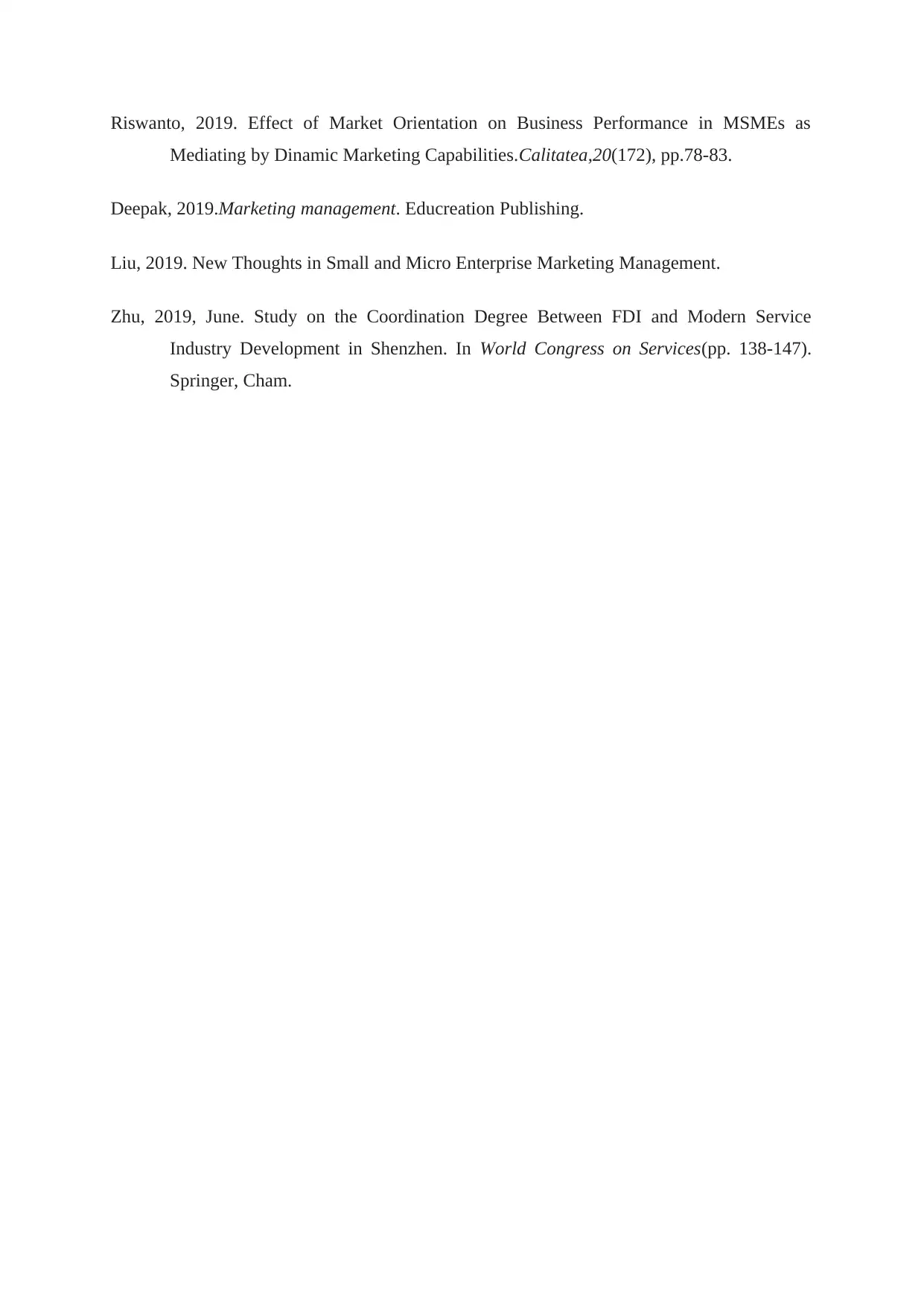
Riswanto, 2019. Effect of Market Orientation on Business Performance in MSMEs as
Mediating by Dinamic Marketing Capabilities.Calitatea,20(172), pp.78-83.
Deepak, 2019.Marketing management. Educreation Publishing.
Liu, 2019. New Thoughts in Small and Micro Enterprise Marketing Management.
Zhu, 2019, June. Study on the Coordination Degree Between FDI and Modern Service
Industry Development in Shenzhen. In World Congress on Services(pp. 138-147).
Springer, Cham.
Mediating by Dinamic Marketing Capabilities.Calitatea,20(172), pp.78-83.
Deepak, 2019.Marketing management. Educreation Publishing.
Liu, 2019. New Thoughts in Small and Micro Enterprise Marketing Management.
Zhu, 2019, June. Study on the Coordination Degree Between FDI and Modern Service
Industry Development in Shenzhen. In World Congress on Services(pp. 138-147).
Springer, Cham.
⊘ This is a preview!⊘
Do you want full access?
Subscribe today to unlock all pages.

Trusted by 1+ million students worldwide
1 out of 9
Related Documents
Your All-in-One AI-Powered Toolkit for Academic Success.
+13062052269
info@desklib.com
Available 24*7 on WhatsApp / Email
![[object Object]](/_next/static/media/star-bottom.7253800d.svg)
Unlock your academic potential
Copyright © 2020–2025 A2Z Services. All Rights Reserved. Developed and managed by ZUCOL.





